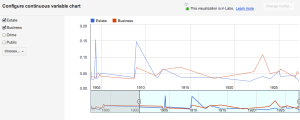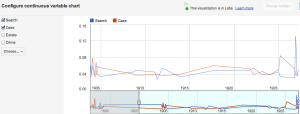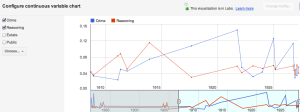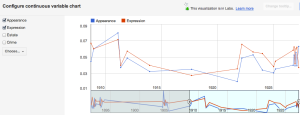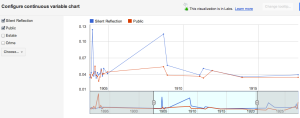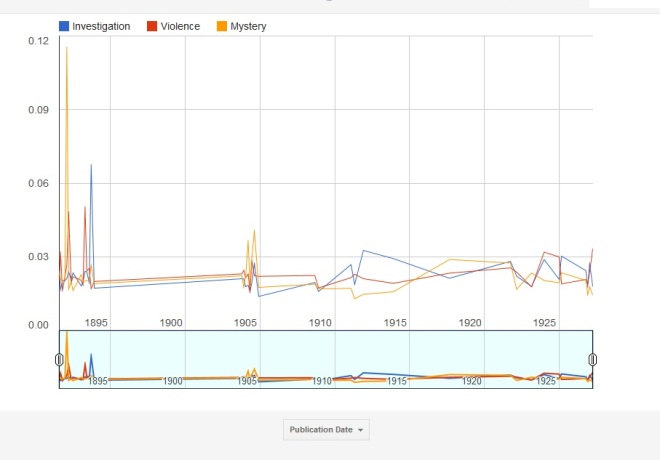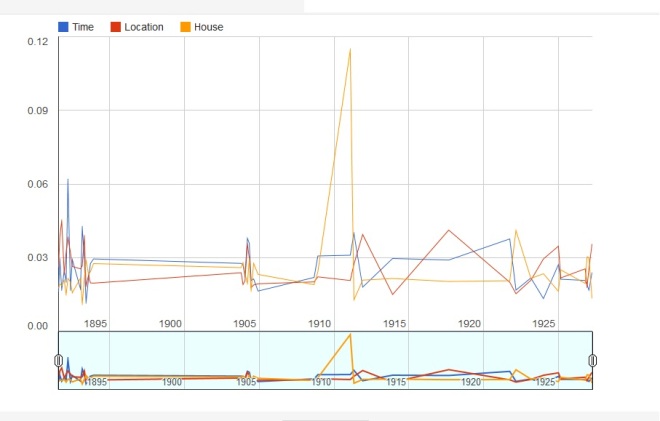The ten topics I have are murder, travel, house, description, religion, divorce, schedule, job, investigation, and performance. While graphing the topics on google fusion tables I put topics like murder and investigation together in one chart to show the correlations between the two and how one rises while the other falls or stays the same. I tried to put together for the most part topics that were similar and would show an interesting relation to one another. I also looked up historical events or the times that certain Holmes stories were published to further analyze what was happening in the graph.
Murder v.s. Investigation
 While looking at the spike of investigation at around 1891 I started to search for murders around 1891. Although I came up short I did realize that Jack the Ripper, a killer who stabbed at least five prostitutes and mutilated four in London, was never really identified although they had several suspects they couldn’t pin point it to one man. While reading about this it came to me that investigation could be at a peak because from 1888 till about 1892 they were investigating and trying to identify this killer. Another chilling discovery was Johann Otto Hoch who was a German con man who claimed up to 50 victims possibly more. I also think he could be the reason investigation spiked because from 1888 till about 1891 he couldn’t be found then he was and in 1906 he was hanged. I believe the reason while investigation and murder correlate so well is that when murder occurs investigation peaks because they are trying to find the murderer, but when murder peaks investigation slowly rises because it is just beginning. This link shows Jack the Ripper as well as Johann Otto Hoch and what I was describing http://en.wikipedia.org/wiki/List_of_serial_killers_before_1900.
While looking at the spike of investigation at around 1891 I started to search for murders around 1891. Although I came up short I did realize that Jack the Ripper, a killer who stabbed at least five prostitutes and mutilated four in London, was never really identified although they had several suspects they couldn’t pin point it to one man. While reading about this it came to me that investigation could be at a peak because from 1888 till about 1892 they were investigating and trying to identify this killer. Another chilling discovery was Johann Otto Hoch who was a German con man who claimed up to 50 victims possibly more. I also think he could be the reason investigation spiked because from 1888 till about 1891 he couldn’t be found then he was and in 1906 he was hanged. I believe the reason while investigation and murder correlate so well is that when murder occurs investigation peaks because they are trying to find the murderer, but when murder peaks investigation slowly rises because it is just beginning. This link shows Jack the Ripper as well as Johann Otto Hoch and what I was describing http://en.wikipedia.org/wiki/List_of_serial_killers_before_1900.
Divorce v.s. Religion

I searched very rigorously to find any correlation with religion and divorce online, but what I did find was that divorce rates in England increased and decreased, but not drastically, and stayed in the same range for the most part.http://www.theguardian.com/news/datablog/2010/jan/28/divorce-rates-marriage-ons is the link I used to find the divorce rates. What I could theorize is, some people that were married by the time they reached their thirties which was about the age you divorced found that they had different religious ideals than their husband. Another theory is that around this time period money could of been an issue with the end of world war one, and peoples husbands either dying or have become disable now are falling on tough times and need money or will simply divorce their husband.
Performance v.s. Schedule
I didn’t know how two relate the two other than when you watch a performance you put it in your schedule but when I dove deeper into what could be the relation between the two I saw so much more. What noticed was that when I went to England recently I noticed that the theater district in the west end was so elaborate with many different shows and as I dove deeper I realized England has been doing theater since the 1700’s. In this link it shows all theater shows form the 1700’s to 2010 in England: http://www.guidetomusicaltheatre.com/london_shows_chronology/1700s-on.html. I also realized that at the peak of the scheduling line (in the graph) it was in 1893. The Holmes story the resident patient came out and it deals with a lot of scheduling jargon which could also be why scheduling peaked around that time. http://www.angelfire.com/ks/landzastanza/publication.html.
House v.s. Description

While reading through some of the Sherlock Holmes stories I noticed that a lot of descriptions relate to house hold items or are in a house which correlated to the rises on the house line in the graph. I also put together that the reason these are so close together on the graph is because they go hand in hand.
Travel v.s. Job

While looking at this graph I noticed that travel peaks a lot. The reason I think it goes up is because a lot of people in England have to travel to get anywhere whether it be taking the tube, or a carriage. While I was in London I noticed everything revolved around transportation which could be the reason for the peak. Also transportation and jobs go hand in hand because in order to get to your job you need to take some mode of transportation.










